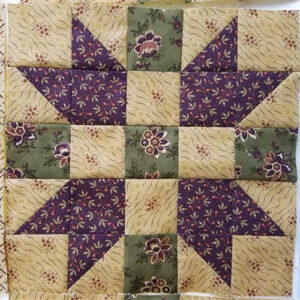Creating a Churn Dasher Quilt Block Pattern is a delightful way to dive into the art of quilting. This timeless design, inspired by the wooden paddles used in old-fashioned butter churns, combines charm and simplicity, making it perfect for beginners and seasoned quilters alike.
Known for its clean lines and geometric balance, the Churn Dasher quilt block is a classic addition to any quilt project.In this tutorial, we’ll guide you through every step of the process, from fabric selection to piecing together your blocks with precision.
Whether you’re crafting a single quilt block or planning an entire quilt, the Churn Dasher pattern offers endless versatility. Its ability to mix and match colors and prints allows you to add a personal touch to every creation.
By following this tutorial, you’ll not only learn the mechanics of assembling this block but also gain insight into fabric cutting, pressing techniques, and tips for accuracy. So, gather your fabrics, prepare your sewing machine, and let’s dive into this step-by-step guide for creating your very own Churn Dasher quilt block!
THE BEST QUILT PATTERNS
What You’ll Need to Create the Churn Dasher Quilt Block
To begin, let’s talk about the materials and tools required to make this beautiful quilt block. Having the right supplies on hand will make the process smooth and enjoyable.
- Fabric selection: The Churn Dasher quilt pattern works best with contrasting colors to make the design pop. Choose a combination of light and dark fabrics for a striking visual effect. Consider solid fabrics for beginners, or experiment with prints for added flair.
- Cutting tools: A rotary cutter, cutting mat, and a quilting ruler are essential for accurate fabric cutting. Precise cuts are key to achieving clean, professional-looking quilt blocks.
- Sewing machine: A reliable sewing machine with a ¼-inch presser foot will ensure accurate seam allowances, which are crucial for proper alignment in this pattern.
- Iron and pressing mat: Pressing your seams as you go will help keep your block flat and ensure a polished final result.
- Quilting thread and pins: High-quality thread in a neutral color and sharp quilting pins will help secure your pieces during assembly.
Once you’ve gathered your materials, it’s time to prepare your fabric. Wash and press all fabrics before cutting to prevent shrinkage and ensure your blocks remain true to size.
Step 1: Cutting the Fabric for the Churn Dasher Quilt Block
Accurate fabric cutting is the foundation of a successful Churn Dasher quilt block. For this tutorial, we’ll create a 12-inch finished block. Here are the fabric cuts and measurements you’ll need:
- Background fabric (light fabric):
- Four 3½-inch squares
- Four 4-inch squares
- Main print fabric (dark fabric):
- One 4½-inch square
- Four 4-inch squares
- Accent fabric (optional):
- Use contrasting prints or colors for the 4½-inch square if you’d like an added design element.
Once your pieces are cut, organize them by size and color. This will streamline the piecing process and ensure accuracy. Take your time during this step—precision cutting is essential for clean, sharp lines in your final block.
Step 2: Creating Half-Square Triangles (HSTs)
The Churn Dasher quilt pattern relies heavily on Half-Square Triangles (HSTs), a versatile quilting element that adds dimension to your block. Here’s how to make them:
- Pair each 4-inch square of background fabric with a 4-inch square of main print fabric, right sides together.
- Draw a diagonal line from corner to corner on the lighter fabric square using a fabric-safe marking pen.
- Sew ¼ inch away from both sides of the marked line. This creates two seams for your HSTs.
- Cut along the marked diagonal line using your rotary cutter. You should now have two HST units from each square pairing.
- Press the seams open or toward the darker fabric, depending on your preference. Use a hot iron to achieve flat, crisp seams.
- Trim each HST to measure exactly 3½ inches square using a quilting ruler. This ensures uniformity in your quilt block assembly.
Creating consistent HSTs is critical for achieving the geometric symmetry that defines the Churn Dasher pattern.
Step 3: Assembling the Churn Dasher Quilt Block
With your fabric pieces and HSTs ready, it’s time to assemble the block. The Churn Dasher quilt block is constructed in a traditional nine-patch layout, consisting of three rows of three squares.
- Arrange your pieces:
- Place the 4½-inch square in the center.
- Surround it with the HSTs and 3½-inch background squares, following the Churn Dasher design. Alternate light and dark fabrics for visual contrast.
- Assemble the rows:
- Sew the squares in each row together using a ¼-inch seam allowance. Be mindful of seam alignment to avoid mismatched points.
- Press the seams in opposite directions for each row to reduce bulk when joining rows.
- Join the rows:
- Pin and sew the rows together, aligning seams carefully for a polished look.
- Press the completed block to finish.
Your Churn Dasher quilt block should now measure 12½ inches square, including seam allowances.
Step 4: Tips for Customizing and Using the Churn Dasher Pattern
The beauty of the Churn Dasher quilt block lies in its adaptability. Here are some creative ways to make the pattern your own:
- Experiment with color schemes: Try monochromatic tones for a modern look or mix bold, bright hues for a playful aesthetic.
- Play with fabric prints: Use florals, stripes, or novelty prints to add personality to your block. Combining solids and prints can also create a stunning visual effect.
- Vary block sizes: Adjust the dimensions of your cuts to create smaller or larger quilt blocks. This allows you to customize your project’s scale.
- Incorporate into larger quilts: Combine multiple Churn Dasher blocks for a cohesive quilt or mix them with other traditional blocks for a sampler quilt.
- Add sashing or borders: Frame your blocks with sashing strips or add a border to highlight the design.
- Turn it into a project: Use the Churn Dasher block for pillow covers, table runners, or wall hangings.
By experimenting with fabrics, layouts, and additional embellishments, you can create a quilt project that’s uniquely yours.
Final Thoughts on the Churn Dasher Quilt Block Pattern
The Churn Dasher quilt block pattern is a versatile and timeless design that offers endless possibilities for creativity. With its simple yet striking layout, it’s a fantastic choice for beginners learning to quilt or experienced quilters seeking a classic addition to their projects.
PATTERN HERE
By mastering the steps in this tutorial—cutting fabric, creating HSTs, and assembling the block—you’ll not only achieve a beautiful quilt block but also enhance your overall quilting skills. Remember, precision and patience are key to bringing your vision to life.
Whether you’re making a single Churn Dasher block or crafting an entire quilt, the process is both rewarding and enjoyable. So, embrace the art of quilting, and let the Churn Dasher pattern inspire your next creative endeavor!


